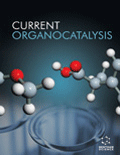- Home
- A-Z Publications
- Current Organocatalysis
- Previous Issues
- Volume 9, Issue 1, 2022
Current Organocatalysis - Volume 9, Issue 1, 2022
Volume 9, Issue 1, 2022
-
-
Organocatalysis: An Overview of its Application in Oxidation and Reduction Reactions
More LessAuthors: Rammyani Pal and Chhanda MukhopadhyayOrganocatalysis was established to be a wide-applicable approach from its inception and rediscovery in the year 2000, where proline was used as a catalyst in aldol condensation and soon after the successful emergence of iminium catalysed reactions in organic synthesis. Development of new potential catalytic systems is always an important as well as an uphill task for scientists and researchers. The fundamental organic synth Read More
-
-
-
Versatile Synthesis of Organic Compounds Derived from Ascorbic Acid
More LessAuthors: Aparna Das and Bimal K. BanikAscorbic acid, also known as Vitamin C, is the most important vitamin observed in diverse food. Ascorbic acid has various applications in several fields. Studies have depicted that in organic synthesis, it can be used as a mediator or substrate. The derivatives of ascorbic acid have been found to possess numerous biological activities. In this review, we report the important derivatives of ascorbic acid, which have significant biol Read More
-
-
-
Green and Sustainable Technology: Efficient Strategy for the Synthesis of Biologically Active Pyrimidine Derivatives
More LessGreen chemistry is also referred to as sustainable technology, which involves the design, synthesis, processing and the use of chemical substances by reducing or eliminating the chemical hazards. This strategy focuses on atom economy, use of safer solvents or chemicals, use of raw materials from renewable resources, consumption of energy and decomposition of the chemical substances to non-toxic material which are eco-f Read More
-
-
-
Isolation, Detection, and Estimation of Various Amylase Producing Bacteria in Various Soil Samples
More LessAuthors: M. A. Mir, Mohammad Waqar Ashraf, Altaf Hussain and Bilal Ahmad MirBackground: Soil is an ultimate source of all types of nutrients, which have both biological and non-biological importance. Studies are being carried out to isolate the various type of micro- organism from soil which has much more importance. So in the present study, amylase-producing bacteria have been isolated from various soil samples. Aim: The isolation, identification, and estimation of various microbial strains for α-amylase Read More
-
-
-
A General Method for the Synthesis of 11H-Indeno[1,2-B]Quinoxalin- 11-Ones and 6H-Indeno[1,2-B]Pyrido[3,2-E]Pyrazin-6-One Derivatives Using Mandelic Acid as an Efficient Organo-catalyst at Room Temperature
More LessAuthors: Aditi Sharma, Gurpreet Kaur, Diksha Singh, Vivek K. Gupta and Bubun BanerjeeAims: Synthesis of 11H-indeno[1,2-b]quinoxalin-11-ones as well as 6H-indeno[ 1,2-b]pyrido[3,2-e]pyrazin-6-one derivatives under greener conditions. Background: Quinoxaline and related skeletons are very common in naturally occurring bioactive compounds. Objective: Design a facile, green and organo-catalyzed method for the synthesis of 11H-indeno[ 1,2-b]quinoxalin-11-ones as well as 6H-indeno[1,2-b]pyrido[3,2-e]p Read More
-
-
-
Ionic Liquid Mediated Graphene-based Pd Nanocomposites for Coupling Reactions
More LessAims: In search of a ligand-free, recyclable, selective, and stable catalytic system, we engineered both Pd/GO and Pd/rGO composites and tested them as catalysts for Heck and Suzuki reactions in [bmim] NTf2 ionic liquid medium. Background: Various reports and reviews have been published on exploring the application of ionic liquids as a reaction medium for different organic transformations. Recently, graphene-supported Pt Read More
-
-
-
Direct Synthesis of Formic Acid from Carbon Dioxide by Hydrogenation Over Ruthenium Metal Doped Titanium Dioxide Nanoparticles in Functionalized Ionic Liquid
More LessBackground: Presently worldwide manufacturing of formic acid follows the permutation of methanol and carbon monoxide in presence of a strong base. But due to the use of toxic CO molecule and easy availability of CO2 molecule in the atmosphere, most of the research has been shifted from the conventional method of formic acid synthesis to direct hydrogenation of CO2 gas using different homogenous and heterogeneous c Read More
-
-
-
Excellent Eco-friendly Selective Alcohols Oxidation by an Acid Functionalized Imidazolium Based Ionic Liquid
More LessAims: A green route for the oxidation of alcohols to corresponding carbonyl compounds in room temperature ionic liquid ([CEMIM]BH4) was developed using hydrogen peroxide as the oxygen source. In aqueous solution at room temperature, 0.2 mol% of ([CEMIM]BH4) showed excellent catalytic properties for selective oxidation of aromatic and aliphatic alcohols. Background: One of the vital reactions in organic synthesis Read More
-
-
-
Immobilized Palladium Nanoparticles on Phosphanamine-grafted Cellulose for Arylation of Uracil
More LessAuthors: Qian Yang, Na Ma, Yangqing He, Xiaojiao Yu and Binghua YaoBackground: The synthesis of 5-arylation uracil nucleosides is an imperative challenge, especially for the method of Suzuki reaction using N-unprotected uracil as materials, which holds the potential to enhance the yield. Objective: The objective of this study was to find a more efficient catalyst to increase the yield of aryluracils and aryluridines. Methods: We first constructed the Phosphanamine-Grafted Cellulose (PAGC) Read More
-
Most Read This Month
Article
content/journals/cocat
Journal
10
5
false
en

Most Cited Most Cited RSS feed
-
-
Liquid Membranes in Catalysis
Authors: Muhammad W. Ashraf and M. Amin Mir
-
- More Less

